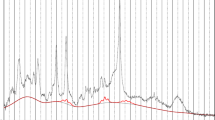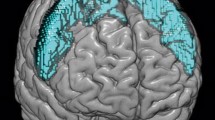Abstract
Signal shortening of the motor cortex in T2-weighted MR images is a frequent finding in patients with amyotrophic lateral sclerosis (ALS). The cause of signal shortening in ALS is unknown, although iron deposits have been suggested. To test this hypothesis, we acquired T2*-weighted gradient-echo (GRE) MR images in addition to T2-weighted turbo spin-echo in 69 patients with ALS. Signal shortening in T2-weighted images was found in 31 patients. In T2*-weighted GRE images, only three patients had signal shortening. One patient with additional bifrontal haemorrhage had frontal but no motor cortex signal shortening. Iron deposits do not cause cortical signal shortening in patients with ALS predominantly. Other factors are presumably more important in the generation of cortical T2 shortening in ALS.



Similar content being viewed by others
References
Goodin D, Rowley H, Olney R (1988) Magnetic resonance imaging in amyotrophic lateral sclerosis. Neurology 23:418–420
Hecht MJ, Fellner F, Fellner C, Hilz MJ, Heuss D, Neundorfer B (2001) MRI-FLAIR images of the head show corticospinal tract alterations in ALS patients more frequently than T2-, T1- and proton-density-weighted images. J Neurol Sci 186:37–44
Hofmann E, Ochs G, Pelzl A, Warmuth-Metz M (1998) The corticospinal tract in amyotrophic lateral sclerosis. Neuroradiology 40:71–75
Ishikawa K, Nagura H, Yokota T, Yamanouchi H (1993) Signal loss in the motor cortex on magnetic resonance images in amyotrophic lateral sclerosis. Ann Neurol 33:218–222
Peretti-Viton P, Azulay JP, Trefouret S, Brunel H, Daniel C, Viton JM et al (1999) MRI of the intracranial corticospinal tracts in amyotrophic and primary lateral sclerosis. Neuroradiology 41:744–749
Hecht MJ, Fellner F, Fellner C, Hilz MJ, Neundörfer B, Heuss D (2002) Hyperintense and hypointense MRI signals of the precentral gyrus and corticospinal tract in ALS: A follow-up examination including FLAIR images. J Neurol Sci 199:59–65
Oba H, Araki T, Ohtomo K, Monzawa S, Uchiyama G, Koizumi K et al (1993) Amyotrophic lateral sclerosis: T2-shortening in motor cortex at MR imaging. Radiology 189:843–846
Imon Y, Yamaguchi S, Katayama S, Oka M, Murata Y, Kajima T et al (1998) A decrease in cerebral cortex intensity on T2-weighted with ageing images of normal subjects. Neuroradiology 40:76–80
Waragai M (1997) MRI and clinical features in amyotrophic lateral sclerosis. Neuroradiology 39:847–851
Ince PG (2000) Neuropathology. In: Brown RH, Meininger V, Swash M (eds) Amyotrophic lateral sclerosis. Dunitz, London, pp 83–112
Rockwell DT, Melhem ER, Bhatia RG (1997) GRASE (Gradient and spin-echo) MR of the brain. AJNR Am J Neuroradiol 18:1923–1928
Brooks BR, Miller RG, Swash M, Munsat TL (2000) El Escorial revisited: revised criteria for the diagnosis of amyotrophic lateral sclerosis. Amyotroph Lateral Scler Other Motor Neuron Disord 1:293–299
Hardy PA, Kucharczyk W, Henkelman RM (1990) Cause of signal loss in MR images of old hemorrhagic lesions. Radiology 174:549–555
Chen JC, Hardy PA, Kucharczyk W, Clauberg M, Joshi JG, Vourlas A et al (1993) MR of human postmortem brain tissue: correlative study between T2 and assys of iron and ferritin in Parkinson and Huntington disease. AJNR Am J Neuroradiol 14:275–281
Bowen BC, Pattany PM, Bradley WG, Murdoch JB, Rotta F, Younis AA et al (2000) MR imaging and localized proton spectroscopy of the precentral gyrus in myatrophic lateral sclerosis. AJNR Am J Neuroradiol 21:647–658
Author information
Authors and Affiliations
Corresponding author
Rights and permissions
About this article
Cite this article
Hecht, M.J., Fellner, C., Schmid, A. et al. Cortical T2 signal shortening in amyotrophic lateral sclerosis is not due to iron deposits. Neuroradiology 47, 805–808 (2005). https://doi.org/10.1007/s00234-005-1421-5
Received:
Accepted:
Published:
Issue Date:
DOI: https://doi.org/10.1007/s00234-005-1421-5




